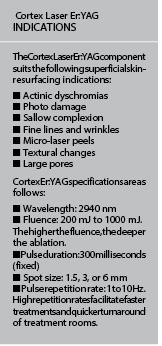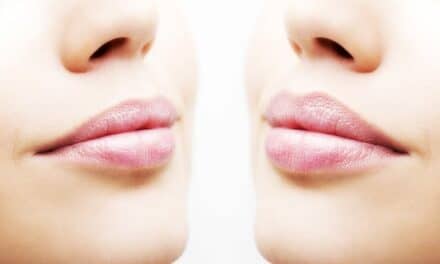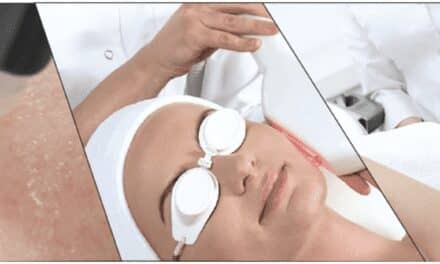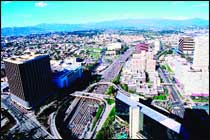The Skin & Aesthetics | February 2014 Plastic Surgery Practice
Laser Pointers
One surgeon’s experience with the Cortex Fractional CO2 Erbium:YAG laser system
By Sam Rizk, MD, FACS
As patients’ desires for minimally invasive rejuvenation procedures grows,1 laser resurfacing procedures are evolving further away from traditional ablative CO2 treatments that carried substantial risks and recovery periods. Instead, fractional laser technologies—which leave areas of untreated skin between microscopic columns of precisely focused thermal damage—offer increasing levels of safety, efficacy, reliability, and patient satisfaction.
Additionally, clinicians now can choose from lasers that offer multiple wavelengths in a single device to fulfill a wide range of indications, while also providing an ever-growing ability to customize treatments. To maximize results, many aesthetic physicians also combine lasers with other procedures ranging from botulinum toxin and dermal filler injections to surgical facelifts and blepharoplasties.
In such a climate, the Cortex Fractional CO2 Erbium:YAG (Er:YAG) Laser System (Ellman International Inc, Hicksville, NY) provides an ideal combination of workhorse resurfacing modalities:
• Fractionated CO2—for deeper rejuvenation and collagen stimulation, minus the risks and extended downtime of traditional CO2 resurfacing
• Er:YAG—for gentler, superficial full-face resurfacing
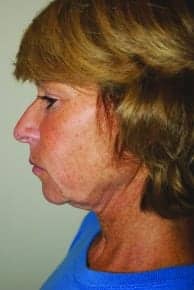 |
| Before facelift and full-face Cortex Fractional CO2 with Erbium:YAG laser resurfacing. |
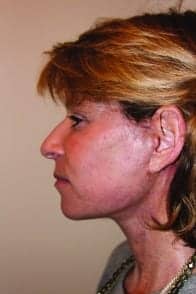 |
| Two weeks post facelift and full-face Cortex Fractional CO2 with Erbium:YAG laser resurfacing. |
Together, this combination provides greater precision, increased safety, and unprecedented flexibility. The Cortex Laser’s pinpoint control of parameters, including pulse width, energy pattern, energy level, and penetration depth, provides a comfortable patient experience that generally requires only topical anesthesia. Furthermore, the device’s dual wavelengths enable physicians to safely treat a broad range of concerns in a variety of skin types. Additionally, the Cortex CO2 Laser alone can function as a precise excisional tool, providing cutting and coagulating functionality for procedures such as blepharoplasties and mole removal.
Compared to single energy-source devices, the Cortex Fractional CO2 Er:YAG Laser delivers far more functionality—without the hefty price tag carried by these more limited devices or by bigger, bulkier competitors. In addition to its clinical advantages, the device provides a relatively small footprint, fast treatment times, and a quick payback period.
CONVENTIONAL RESURFACING LIMITATIONS
During the 1990s, the ablative CO2 laser emerged as the gold standard resurfacing modality in terms of efficacy and reliability of results. With these advantages, however, came 7 to 10 days of postprocedural swelling and peeling, during which patients had to significantly restrict their activities while healing and re-epithelialization occurred. Subsequently, complete recovery and resolution of postprocedural erythema could take months. Other drawbacks of traditional, fully ablative CO2 resurfacing included risks of post-treatment hyper- or hypopigmentation. Such procedures also could leave noticeable demarcation lines between treated and untreated areas.
Additionally, patients found ablative resurfacing painful, usually requiring general anesthesia. For these reasons, ablative treatments proved ill-suited to more sensitive areas of thinner skin, such as the neck, the dorsal hands, and the perioral and periorbital areas.
As an alternative to ablative technologies, nonablative modalities such as intense pulsed light (IPL) devices, pulsed dye lasers (PDLs), and radiofrequency devices offer fewer side effects, more patient comfort, and far less downtime—along with far less dramatic results in terms of deeper long-term benefits such as collagen remodeling and wrinkle correction.
Fractional ablation, on the other hand, delivers results equivalent to those of ablative resurfacing, with less downtime and fewer risks. The Cortex Fractional CO2 Laser emits light at a wavelength of 10,600 nm. The light is absorbed strongly by water down to the lower dermis. Each pulse of CO2 energy vaporizes a microscopic column of tissue, leaving small areas of untreated skin between columns. As ablation occurs, deep heating stimulates collagen growth and remodeling. Distributing the laser energy in an even pattern allows for quicker healing and reduces patient downtime.
DUAL-WAVELENGTH SOLUTION
All fractionally ablative resurfacing devices are far from equal. Before the introduction of the Cortex Laser, typical fractionally ablative lasers penetrated the skin to a depth of 400 to 800 µm.2 The Er:YAG light source provides full surface ablation to a depth of 100 µm, allowing the Cortex Laser to achieve maximum flexibility in a single device.
Fractional CO2 and fully ablative Er:YAG work synergistically for a variety of indications. For example, performing a shallow, fully ablative Er:YAG treatment after fractional CO2 resurfacing removes the zone of thermal necrosis created by the CO2 treatment.3 Ablating the epidermis in this manner promotes prompt healing and reduces the duration of crusting, swelling, and itching after fractional CO2 treatment. In combination, these procedures can substantially improve medium to deep (Grade III) facial rhytids. Pretreatment with botulinum toxin injections allows for further improvement of wrinkles.
Similarly, for dyschromia and lentigines, you can perform a fractional CO2 treatment, followed by Er:YAG for spot treatment of the lentigines. To add the benefits of skin resurfacing to results of more invasive procedures, physicians also have performed Cortex Laser treatment simultaneously with surgical procedures such as face and neck lifts and blepharoplasties.
Other physicians find the laser particularly useful for patients in their 50s and early 60s who have upper and lower dermatochalasis and moderate dyschromia and rhytids, but are not ready for a facelift. In such cases, the Cortex allows you to perform an upper laser blepharoplasty, a lower transconjunctival blepharoplasty, and full-face, dual-mode CO2 and Er:YAG resurfacing with the same tool.
As a stand-alone procedure, treatment with the Cortex CO2 Laser also helps in reducing severe acne scarring, often with just a few passes.
FLEXIBILITY ON ALL FRONTS
The Cortex Fractional CO2 Laser’s ability to individualize treatment for each patient stems from the fact that users can adjust virtually every treatment parameter as needed.
The distance between individual treatment columns determines how much surface area a treatment covers. In this regard, the Cortex Fractional CO2 Laser can cover from 13% to 95% of the skin’s surface area, allowing flexibility for the patient and indication being treated. Different density settings enable the following capabilities:
• 13% to 17%: Feathering (subtly blending the edge of a treated area into surrounding skin tones)
• 20% to 35%: Treating moderate wrinkles, or any type of wrinkles in Asian patients. Fitzpatrick skin types III and IV require extra caution and, in most cases, up to 6 weeks of topical hydroquinone use before laser treatment to minimize the risk of post-inflammatory hyperpigmentation.
• 80% to 95%: Treating severe wrinkles or raised scars
The longer the heat is delivered to the skin, the more the thermal effect with the treatment columns expanding laterally in the epidermis. Pulse durations of 0.2 to 6 ms are typically used as follows:
• 0.2 to 0.5 ms: for less aggressive treatments
• 1 to 2 ms: moderate treatments, or treatment of Asian patients
• 3 to 6 ms: more aggressive treatments
SPOT SIZE, SCANNER FOOTPRINT, AND LASER FLUENCE
With the small fractional spot size of 150 µm, the Cortex CO2 Laser allows for treatment with the most popular settings.
Physicians also can adjust the width, length, and shape of each individual scan pattern (square, rectangle, triangle, hexagon, or “square doughnut”) from 3 mm to 18 mm, depending on the area being treated. Using a scan pattern of up to 324 mm² (18 x 18 mm) allows for faster treatments—usually about 30 minutes—than competitive devices generally provide.
The higher the fluence, the deeper the heat and treatment penetrate. With an adjustable power level up to 40 W, the Cortex Fractional CO2 Laser delivers up to 60 mJ per spot. To maximize safety and consistency, the laser energy is redistributed into a pattern of high- and low-fluence treatment areas. Areas treated with higher fluences experience more collagen remodeling after treatment. Delivering the laser energy with varied levels of heat intensity means that the device uses less energy in total to reach the ideal penetration depth (about 300 µm) and achieves similar effects as more aggressive treatments, but with less pain.
CO2 TREATMENT PARAMETERS
Using a treatment density of 13% to 95% and a micropulse duration of 0.2 to 6 ms, you can design treatment parameters for the face, periocular region, neck, chest, and hands within the following guidelines:
• Wattage: Facial treatments can use anywhere between 16 and 25 W. The hands require 19 to 25 W. The neck, chest, and periocular region must be treated with no more than 16 to 18 W.
• Laser passes per treatment: one to two
• Total number of treatments: one to three
• Treatment interval: 6 to 12 months
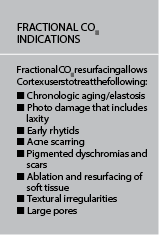
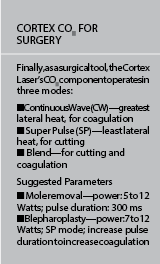
CO2 TREATMENT PROTOCOL
Before treatment, make sure each patient has no signs of skin cancer. Remove all makeup and visible hairs from the area to be treated, then apply topical anesthetic. Wait 30 to 45 minutes, then thoroughly remove topical anesthetic.
For best results, gently stretch the skin during treatment and perform each treatment with a single pass. You may perform a second pass over problem areas, but this increases the risk of post-treatment hyperpigmentation. For patient comfort, have an assistant apply a cold-air chiller during treatment or cold packs immediately after an area has been treated.
To avoid leaving untreated areas, hold the handpiece perpendicular to the skin and overlap scan patterns slightly. Start with the forehead, then progress to the lower face. Full-face coverage allows for uniform post-treatment color and texture. Also, be sure to treat the entire nose. Do not, however, treat the vermilion border of the lip, the eyebrows, or other areas covered by hair.
To blend between treated and untreated areas, such as along the jawline, use the feathering technique. After treatment, most doctors do not debride or use wound dressings. Instead, the denatured eschar created by the treatment can serve as a biocompatible wound dressing.
Post-treatment instructions for patients mirror those of virtually any fractionally ablative device; patients must keep the treated area moist with a generous coat of lubricant such as Aquaphor, use cold compresses as needed, and avoid direct sunlight for at least the first 3 days. They can gently wash but must not pick or scratch the skin. More aggressive washing, along with use of light (powder) mineral-based makeup and nonirritating sunscreen, may begin on post-treatment day 4 through 7. Patients may return to their normal skin care regimens after about a week.
COMPLICATIONS, RESULTS, AND PROGNOSIS
Although rare in the hands of trained and skilled physicians, complications can occur. Along with hyper- and hypopigmentation, fractional laser resurfacing complications can include post-auricular skin slough. Other complications can include minor swelling, scarring, and formation of fibrotic tissue, all of which generally resolve with time and/or topical steroid application.
Fractional laser resurfacing generally produces good to excellent results, depending on the indication and skills of the treating physician. The treatment tends to improve actinic changes to the greatest degree, followed by wrinkles, which can improve 60% to 80%, then scars. Results are less predictable in the forehead, neck, malar bags, deeper cheek folds, and in excess upper eyelid skin. Additionally, fractional laser resurfacing generally improves static lines more effectively than dynamic lines.
Results continue to improve after the initial healing period. Because heat stimulates the subdermal collagen to regenerate over 60 to 90 days, patients should be reassessed and/or retreated at 3 to 6 months if a second treatment is needed.
ER:YAG LASER FOR SUPERFICIAL RESURFACING
The Cortex Er:YAG component allows for fine control of treatment energy and precise ablation of superficial tissue. Its uniquely engineered technology increases patient comfort and reduces downtime.
More specifically, the device combines a proprietary fluence level with an extra-long pulse width to precisely ablate the epidermis without exposing the underlying dermis. Thus, the gentler nature of the Er:YAG wavelength enables physicians to treat sensitive skin of the neck, dorsal hands, and perioral and periorbital areas without general anesthesia. Some patients may require nerve blocks for treatment of sensitive areas. With an ablation depth of 20 to 100 µm, the Er:YAG component is suitable for skin types I through V.
In addition to its affordable price and efficient treatment times, the Cortex Fractional CO2 Er:YAG Laser uses no consumables. With other fractional resurfacing lasers, disposable items can cost up to $400 per treatment. Finally, with its ergonomic handpiece design and modest footprint (36 cm x 46 cm x 145 cm), this single device can take the place of multiple less flexible technologies.
CONCLUSION
Whether as a stand-alone procedure or in combination with other rejuvenation modalities ranging from fillers to facelifts, the Cortex Fractional CO2/Er:YAG Laser delivers the advantages of both superficial and deeper resurfacing in a single, highly customizable unit. Its fractional CO2 capabilities allow physicians to address indications ranging from age spots and wrinkles to acne scars. The laser’s Er:YAG capabilities add a superficial refinishing touch for problems such as photo damage, fine lines, and wrinkles.
I have found the Cortex to be an excellent complement to my facelift technique. I usually use it in combination with a facelift to resurface the whole face up to the ear and jawline, avoiding the segmental layering and discoloration of older fully ablative laser techniques. For the lower eyelids, it is effective for tightening lower eyelid skin after removing fat pockets through the transconjunctival approach, thereby eliminating external scar, malpositioning, and scleral show that can occur with skin removal in lower eyelids. This is an excellent adjunct as lower-lid blepharoplasties do not effectively address crow’s feet, and the Cortex reduces these fine rhytides in conjunction with lower-lid surgery.
Samieh S. Rizk, MD, FACS, is a double board-certified facial plastic surgeon and director of Manhattan Facial Plastic Surgery in New York City. He can be reached via [email protected]. Rizk has no financial association with Ellman International.
References
1. Cosmetic Surgery National Data Bank 2012. The American Society for Aesthetic Plastic Surgery. Accessed September 12, 2013.
2. Gold MH. Update on fractional laser technology. J Clin Aesthet Dermatol. 2010;3(1):42-50.
3. Mittelman H, Furr M, Lay PC. Combined fractionated CO2 and low-power erbium:YAG laser treatments. Facial Plast Surg Clin North Am. 2012;20(2):135-143.
Original citation for this article: Rizk, S. Laser pointers: One surgeon’s experience with the cortex fractional CO2 erbium:YAG laser system, Plastic Surgery Practice. 2014; February: 20-23


